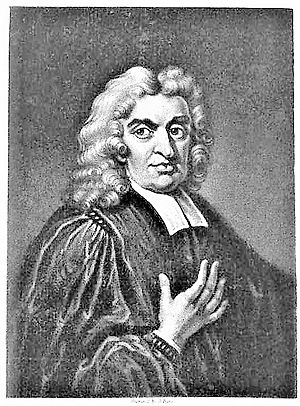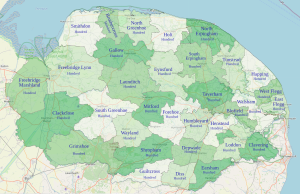Francis Blomefield facts for kids

Francis Blomefield (born July 23, 1705 – died January 16, 1752) was an English historian. He was a priest and a member of the Society of Antiquaries of London. An antiquarian is someone who studies old things.
Blomefield wrote a detailed history of Norfolk, a county in England. His big book was called An Essay Towards a Topographical History of the County of Norfolk. It covered the city of Norwich, the town of Thetford, and many villages. He died before finishing the book. His friend, Charles Parkin, helped complete it.
A historian named Walter Rye said that Blomefield looked a lot like the astronomer John Flamsteed. Because of this, a picture of Flamsteed was used as the front page image for one of Blomefield's books. Later, his history book was printed again in 11 volumes between 1805 and 1810.
Contents
Early Life and Family
Francis Blomefield was born in a village called Fersfield in Norfolk, England. This was on July 23, 1705. He was the oldest son of Henry Blomefield. His father owned land in Fersfield. Francis's mother was Alice Batch. Her family was from King's Lynn in Norfolk. The Blomefield family had lived in Fersfield for many generations.
Education and Career
Blomefield went to grammar schools in Diss and Thetford. In 1724, he went to Caius College at Cambridge University. He earned his first degree in 1727 and a master's degree in 1728.
In 1729, he became a priest. Soon after, he became the Rector (a type of priest) of two churches in Norfolk: Hargham and Fersfield.
Starting His History Work
Even as a teenager, Blomefield loved history. When he was 15, he started writing down old inscriptions from churches. He visited churches in Norfolk, Suffolk, and Cambridgeshire. While at college, he also took notes on family histories and coats of arms.
After university, he planned to write about the history of Cambridgeshire. But in 1732, he got a chance to use a huge collection of historical notes about Norfolk. These notes belonged to another antiquarian, Peter Le Neve. This made Blomefield change his focus to Norfolk.
Writing the History of Norfolk
In 1733, Blomefield announced his plan to write An Essay towards a Topographical History of Norfolk. While gathering information, he even found some of the famous Paston Letters. These are important historical letters.
By 1736, he was ready to start printing his book. He had his own printing press at his home in Fersfield. His friend, Charles Parkin, helped him. The first volume of his History of Norfolk was finished in 1739.
The second volume was about the city of Norwich. He started it in 1741 and finished it in 1745. This volume took over four years to make. It seems he lived in Norwich while it was being printed.
In 1751, Blomefield published his notes on Cambridgeshire, called Collectanea Cantabrigiensia. Sadly, a fire destroyed his printing press and many copies of his first book. This meant he had to start some of his work over.
He faced many challenges with printers and artists. He even temporarily lost his notes for one part of the book. Blomefield was about two-thirds through his third volume when he got smallpox during a trip to London. He died in Fersfield in January 1752.
Family Life
Francis Blomefield married Mary Womock on September 1, 1732. Mary was the daughter of a priest named Lawrence Womock. Francis and Mary had three daughters. Two of them lived to be adults. Their daughters included Elizabeth (born 1733) and Alice (who died as a baby in 1735).
Who Finished the Book?
Blomefield's friend, Charles Parkin, continued the History of Norfolk after Blomefield's death. Parkin worked on it from 1753 to 1765. However, his work was not as detailed or accurate as Blomefield's.
The rest of volume 3 and two more volumes were published between 1769 and 1775. Later, the entire work was reprinted in 11 large volumes in London from 1805 to 1810.
Why Blomefield's Work is Important
Blomefield's History of Norfolk was very detailed and mostly correct for its time. It is considered one of the best county histories from that period. He used many existing historical notes from other scholars. He also added a lot of his own research.
Historians today still see his work as a huge achievement. It was a "labor of love" for him, meaning he did it because he truly loved it. Even though it had some small errors, it is still the main history book for Norfolk. The parts about Norwich are still the most complete record of the city's old buildings and history.
Main Works
Francis Blomefield's most famous work is:
- An Essay Towards a Topographical History of the County of Norfolk (11 volumes, published 1805–1810). This book describes towns, villages, churches, castles, and families in Norfolk. It includes old records, inscriptions, and drawings.


